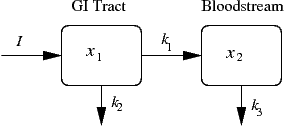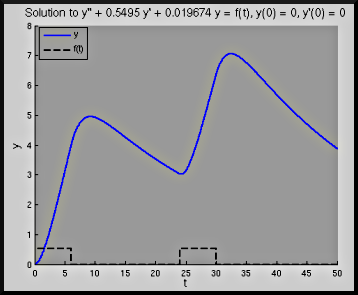Abstract
This revisits the two-compartment drug model previously considered as a system. This takes an input to a patient's gastrointestinal (GI) tract, which is then absorbed into the bloodstream and may be eliminated from both compartments. For this demonstration, we eliminate the amount \(x_1\) in the GI tract and obtain a single equation for the amount in the blood, \(y = x_2\), \[ y'' + (k_1 + k_2 + k_3) y' + k_3(k_1 + k_2) y = k_1 I. \] In this demonstration we take \[ I = f(t) = \begin{cases} \frac{I_0}{t_0}, & t < t_0\\ 0, & \mbox{else}\end{cases} \] with the possibility of adding additional doses every \(t_1\) hours.
Use Cases
Lecture: We can motivate the model from the two-compartment illustration; the equation may be then presented without further derivation. The solution may be graphed for varying numbers of doses taken. This equation is well-suited to analysis with Laplace transforms because of the (successive) discontinuities in the forcing term. The demonstrations show the solution to this equation given the different parameter values.
Outside of Lecture: The second-order equation in \(y\) comes from the system of equations in the two-compartment drug model. It's well worth seeing that you can derive it from the system of equations there. Then Graph the given \(I = f(t)\) to see what it looks like, and to see how it is discontinuous. For the case of a single dose of the drug, solve the problem by hand (note that you will need to solve first for \( t < t_0 \) and then again for \( t\ge t_0 \); it may be useful to take values for the parameter from the description below). Finally, consider the graph of the solution that is obtained from the demonstration and verify that it makes sense.
Model Description
Our two-compartment model is illustrated as

Here the drug input \(I\) enters the GI tract, resulting in an amount
\(x_1(t)\) of the drug being present there. In any time interval
some fraction of that (\(k_1\)) passes on to the bloodstream, while some
fraction (\(k_2\)) is eliminated from the body. We call the amount of
the drug in the bloodstream \(x_2(t)\). Similarly in the bloodstream we
expect some fraction (\(k_3\)) to be filtered out by the kidneys. We
expect that the amount of the drug in the bloodstream will be
significant for the drug's effectiveness.
Assuming that all transfers between and out of the compartments indicated above are proportional to the amount of the drug present there, we obtain the simple linear system \[ \begin{aligned} x_1'(t) &= I - (k_1 + k_2)\, x_1(t)\\ x_2'(t) &= k_1\, x_1(t) - k_3\, x_2(t). \end{aligned} \]
Following the analysis in the two-compartment drug model, we have \(k_1\approx 0.128\), \(k_2\approx 0.383\), and \(k_3\approx 0.0385\). Finally, we may take \[ I(t) = \begin{cases} 25/t_0, & t \le t_0\\ 0 & t > t_0. \end{cases} \] For our purposes, we assume that \(t_0 = 6\).
Matlab Demos
Our demos:
- Antahistamine_Graph.m:
A very simple demo that numerically solves the ODE and plots the
solution. The parameters \(a = k_1 + k_2 + k_3\), \( b = k_3(k_1 +
k_2) \),
\(I_0\) and \(t_0 = h\), the number of doses to administer
(
num_doses) and timing between doses \(t_1\) are all set at the beginning of the file. [show figure]
Looking at the Model
Some questions that may be worth considering:
- How is the solution we find here related to our solution techniques for linear constant coefficient problems?
- How can we use linearity to find a solution for the case of repeated doses?
- If we dose repeatedly forever, is there a limiting value for the amount of antihistamine in the blood? What is it?
